稀土-1,10-菲啰啉配合物的热分解动力学研究
稀土席夫碱邻菲咯啉三元配合物的合成及其生物活性研究
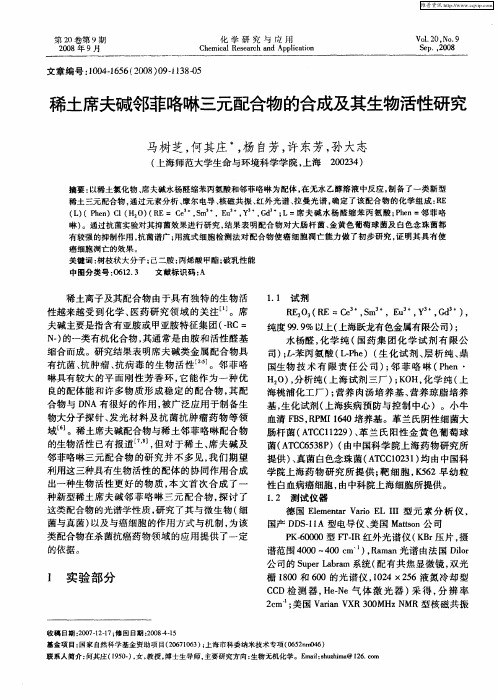
文章编 号 :0 41 5 ( 0 8 0 一180 10 —6 6 20 ) 9 j3 -5
稀土席夫碱邻菲咯啉三元配合物的合成及其生物活性研究
马树芝 , 何其庄 , 自芳, 杨 许东 芳 , 孙大 志
( 海师 范大 学生命 与环境 科学 学 院 , 海 上 上 203 ) 024
摘要 : 以稀土氯化 物 、 席夫碱水杨醛缩苯丙氨酸和邻菲咯啉 为配体 , 在无水 乙醇溶液 中反 应, 制备 了一类新 型 稀土 三元配合物 , 通过元素分析 、 摩尔 电导 、 核磁共振 、 红外光 谱 、 拉曼光 谱 , 定 了该配 合物 的化学组成 : E 确 R ( ) h n 1( ) R = C “ ,m , u , ¨ , d ; L (P e )C H 0 ( E e s ¨ E ¨ Y G ¨ L=席夫 碱水 杨醛 缩苯 丙 氨酸 ; hn=邻 菲 咯 Pe
邻菲 咯啉三 元 配 合 物 的研 究 并 不 多 见 , 我们 期 望 利用这三种具有生物活性的配体 的协同作用合成 出一种 生物 活 性 更 好 的物 质 , 文 首 次合 成 了一 本 种 新 型稀土 席 夫 碱 邻 菲 咯 啉 三 元 配 合 物 , 讨 了 探 这类配 合物 的光谱 学性 质 , 究 了其 与微 生物 ( 研 细 菌与真 菌 ) 以及与 癌细胞 的作 用 方式 与 机 制 , 为该
维普资讯
第2 0卷第 9期 20 0 8年 9月
化 学 研 究 与 应 用
C e c lR s a c n pi ain h mia e e r h a d Ap l t c o
Vo . 0. o 9 12 N . Sp 2 0 e ., 0 8
1 实验 部 分
栅 10 80和 60的光谱仪 ,04× 5 0 12 2 6液氮冷却型 C D检 测 器, e e气 体激 光 器 ) 得 , 辨 率 C H— N 采 分 2 m~ 美 国 V r nV R 3 0 c ; ai X 0 MHzN a MR型核 磁共 振
稀土水杨酸邻菲罗啉三元固体配合物的研究_王则民
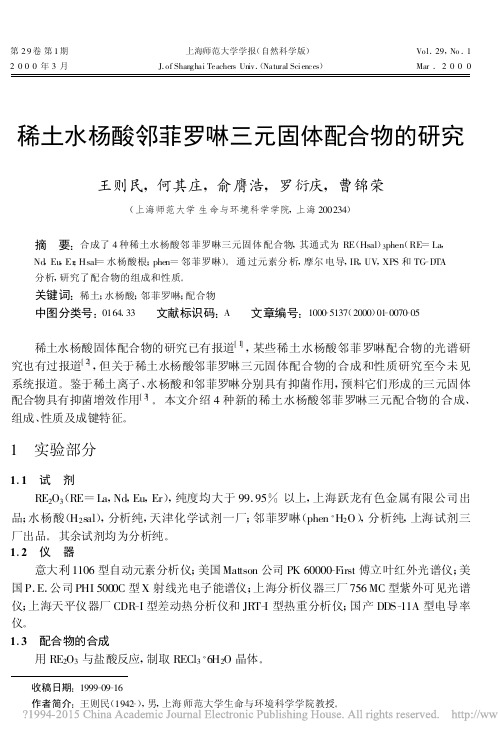
第29卷第1期 上海师范大学学报(自然科学版)Vol .29,No .12000年3月 J .of Shanghai Teachers Univ .(Natural Sciences )Mar .2000稀土水杨酸邻菲罗啉三元固体配合物的研究王则民,何其庄,俞膺浩,罗衍庆,曹锦荣(上海师范大学生命与环境科学学院,上海200234)摘 要:合成了4种稀土水杨酸邻菲罗啉三元固体配合物,其通式为RE (Hsal )3phen (RE =La ,Nd ,Eu ,Er ;Hsal =水杨酸根;phen =邻菲罗啉)。
通过元素分析,摩尔电导,IR ,UV ,XPS 和TG -DTA 分析,研究了配合物的组成和性质。
关键词:稀土;水杨酸;邻菲罗啉;配合物中图分类号:0164.33 文献标识码:A 文章编号:1000-5137(2000)01-0070-05 收稿日期:1999-09-16作者简介:王则民(1942-),男,上海师范大学生命与环境科学学院教授。
稀土水杨酸固体配合物的研究已有报道[1],某些稀土水杨酸邻菲罗啉配合物的光谱研究也有过报道[2],但关于稀土水杨酸邻菲罗啉三元固体配合物的合成和性质研究至今未见系统报道。
鉴于稀土离子、水杨酸和邻菲罗啉分别具有抑菌作用,预料它们形成的三元固体配合物具有抑菌增效作用[3]。
本文介绍4种新的稀土水杨酸邻菲罗啉三元配合物的合成、组成、性质及成键特征。
1 实验部分1.1 试 剂RE 2O 3(RE =La ,Nd ,Eu ,Er ),纯度均大于99.95%以上,上海跃龙有色金属有限公司出品;水杨酸(H 2sal ),分析纯,天津化学试剂一厂;邻菲罗啉(phen ·H 2O ),分析纯,上海试剂三厂出品。
其余试剂均为分析纯。
1.2 仪 器意大利1106型自动元素分析仪;美国Mattson 公司PK 60000-First 傅立叶红外光谱仪;美国P .E .公司PHI 5000C 型X 射线光电子能谱仪;上海分析仪器三厂756MC 型紫外可见光谱仪;上海天平仪器厂CDR -I 型差动热分析仪和JRT -I 型热重分析仪;国产DDS -11A 型电导率仪。
间硝基苯甲酸稀土配合物与大肠杆菌作用的热动力学研究
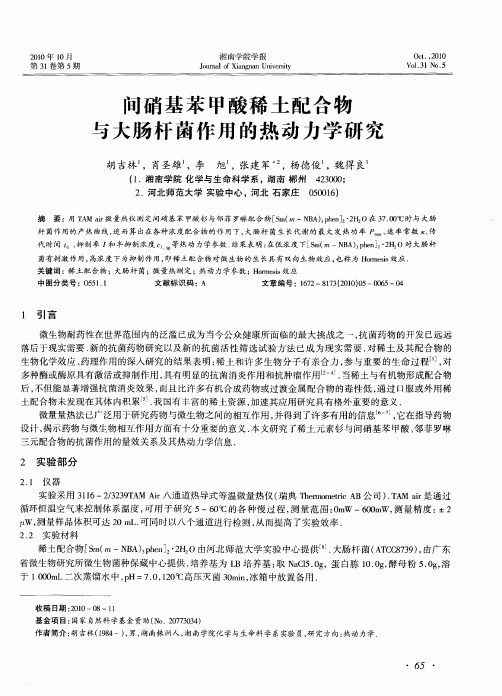
落后于现 实需要 . 的抗 菌药 物研究 以及 新 的抗 菌 活性 筛 选试 验 方 法 已成 为现 实需 要 . 稀 土及 其配 合物 的 新 对 生物化学 效应 、 药理作 用 的深入研 究 的结 果表 明 : 土 和许 多 生物 分 子有 亲合 力 , 与重 要 的生 命 过 程… , 稀 参 对 多种酶或 酶原具 有激 活或抑 制作用 , 具有 明显 的抗菌 消炎作 用 和抗肿 瘤作用 4. 土与 有机物形 成配 合物 IJ当稀 后, 不但 能显著增 强抗 菌消炎 效果 , 而且 比许多 有机合 成药 物或过 渡金 属配合 物 的毒 性低 , 过 口服或 外用 稀 通 土配合物 未发现 在其体 内积 累 J我 国有丰 富 的稀 土资源 , 速其应 用研究 具有格 外重 要 的意 义 . . 加
匀, 编号 , 盖上瓶 盖并用 专用钳 压 紧 . 然后将 安瓿瓶 依 次 吊入 仪器 的通道 , 行 数据 采集 , 进 连续 记 录在 3 .0C 7 0 c 大肠杆 菌生 长的产热 功率 ( ) P— 曲线 .
3 结 果 与讨 论
3 1 大肠 杆菌 的生长产 热 曲线 .
如图 1 所示 .
2 2 实验材料 .
稀土 配合物 [m( S m—N A)pe ̄・I O由河 北师 范 大学 实验 中心提供 随. B hn:2/ - 2 ]大肠 杆 菌 ( T C79 , A C 83 )由广 东 省微 生物研 究所微 生物 菌种保 藏 中心提供 . 培养 基 为 L B培养 基 : N C5 0 , 白胨 1.g酵母 粉 50 , 取 a1.g 蛋 00, .g溶
用DSC法研究配合物[Sm(m-BrBA)3phen]2·2H2O脱水反应的动力学
![用DSC法研究配合物[Sm(m-BrBA)3phen]2·2H2O脱水反应的动力学](https://img.taocdn.com/s3/m/6c786527e2bd960590c6779b.png)
柴 兴泉 , 任 宁
( 郸 学院 化学 系 ,河北 邯 郸 0 6 0 ) 邯 5 0 5
摘 要: 合成 了稀土配合物[ m m BB ) hn 22 2 ( . rA 间溴苯 甲酸 ; h n 邻菲罗啉 ) 用差示扫 描量热 ( s ) s ( ・ rA a e ]・H 0 m BB , p pe , 。 D c 技术研究 了该配合物 脱水反应 的动力学方程和动力学 参数 。 验数 据用 双 等双步 法处 理 , 到脱 水反应 的动力 学方 程为 d /t ep 一E 尺 ) (. ) 一I 实 得 ad =A x ( , 1 [ n a
一
和分解反应动力学研 究的重要手段 , 其研究 方法 也很多 , 如微分法与积分法相结合 的方法 ] 等 , 温法与非等温法相结合 的方法 , ] 动力学模式函数 法[ 等。 8 本文新合成配合物 [m( — rA ,hn S m BB ) e ]・ p
2 利 用 D C技 术 ,采取 一 种 较 新 的处 理 动 力 H O, S
K r 片 ,测量 范 围 为 40 B压 0 0—40c 0 m~。紫外 吸 收 光 谱在 u 一5 1 V20 分光光 度 计 ( 日本 ,岛 津 ) 测定 。 上
Fy nWa — zw ln — l O a a方 程【 l “
l =l g g l f (
) 235 .46 _ .1 .. 57E 0
53卷 1
这里 ,G( ) 积 分 形 式 的 机 制 函数 ,A 为指 前 因 a为 子 ,R 为 气 体 常数 ,E 为 活 化 能 , 为绝 对 温 度 。 将几 条 T 曲 线 上 同一 温 度 处 的 a值 和 不 同 的机 A
丙烯酸稀土与邻菲罗啉配合物的合成与表征_王学智
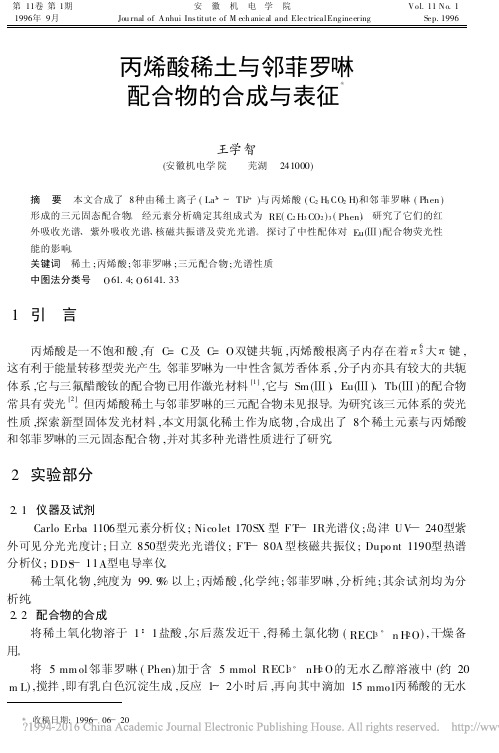
第11卷第1期安 徽 机 电 学 院Vol.11No.1 1996年9月Jou rnal of Anhui Ins titute of M ech anical and ElectricalEngineering Sep.1996丙烯酸稀土与邻菲罗啉配合物的合成与表征王学智(安徽机电学院 芜湖 241000)摘 要 本文合成了8种由稀土离子(La3+~T b3+)与丙烯酸(C2H3CO2H)和邻菲罗啉(Phen)形成的三元固态配合物。
经元素分析确定其组成式为RE(C2H3CO2)3(Phen)。
研究了它们的红外吸收光谱、紫外吸收光谱、核磁共振谱及荧光光谱。
探讨了中性配体对Eu(Ⅲ)配合物荧光性能的影响。
关键词 稀土;丙烯酸;邻菲罗啉;三元配合物;光谱性质中图法分类号 O61.4;O6141.331 引 言丙烯酸是一不饱和酸,有C=C及C=O双键共轭,丙烯酸根离子内存在着π65大π键,这有利于能量转移型荧光产生。
邻菲罗啉为一中性含氮芳香体系,分子内亦具有较大的共轭体系,它与三氟醋酸钕的配合物已用作激光材料[1],它与Sm(Ⅲ)、Eu(Ⅲ)、Tb(Ⅲ)的配合物常具有荧光[2]。
但丙烯酸稀土与邻菲罗啉的三元配合物未见报导。
为研究该三元体系的荧光性质,探索新型固体发光材料,本文用氯化稀土作为底物,合成出了8个稀土元素与丙烯酸和邻菲罗啉的三元固态配合物,并对其多种光谱性质进行了研究。
2 实验部分2.1 仪器及试剂Carlo Erba1106型元素分析仪;Nico let170SX型FT—IR光谱仪;岛津UV—240型紫外可见分光光度计;日立850型荧光光谱仪;FT—80A型核磁共振仪;Dupo nt1190型热谱分析仪;DDS—11A型电导率仪。
稀土氧化物,纯度为99.9%以上;丙烯酸,化学纯;邻菲罗啉,分析纯;其余试剂均为分析纯。
2.2 配合物的合成将稀土氧化物溶于1∶1盐酸,尔后蒸发近干,得稀土氯化物(RECl3·n H2O),干燥备用。
稀土-3-己烯二酸-1,10-邻菲咯啉兰元配合物的合成,表征和荧光性能研究
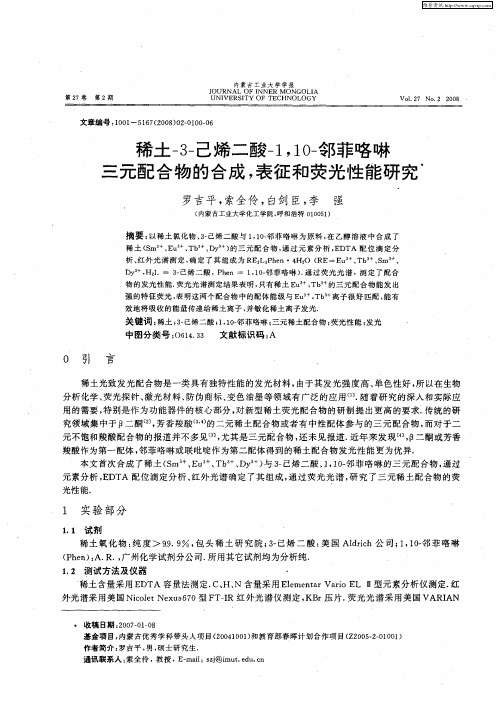
光性能 .
1 实 验部 分
1 1 试 剂 .
稀 土 氧 化 物 : 度 > 9. % , 头 稀 土 研 究 院 ;一 纯 ,9 包 9 3 已烯 二 酸 : 国 Alr h公 司 ; , 0邻 菲 咯 啉 美 di c 1 1一
收 稿 日期 :0 70 —8 2 0 —10
・
基金项 且 内蒙古优秀学科 带头 人项 目(0 4 0 1 和教 育部春晖计划合作项 目 (2 0 ——1 0 ) 2010) Z 0 520 0 1
作 者 简 介 : 吉 平 , , 士 研 究 生. 罗 男 硕 通 讯 联 系 人 : 全 伶 , 授 , — i: z i teu c 索 教 E mal sj mu. d .n @
稀 土 (m” 、 u 、 ” 、 y ) S E ” Tb D 。 的三 元 配 合 物 , 过 元 素 分 析 , D 通 E TA 配 位 滴 定 分
析 、 外 光 谱 测 定 , 定 了 其 组 成 为 RE I P e 红 确 2 。h n・4 O ( H2 RE—E z Tb 、 m” 、 u 、 ” S
关键 词 : 稀土;一 3己烯二酸 ;,0邻菲咯啉; 11一 三元稀土配合物 ; 荧光性能; 发光 中图分 类号 : 643 文献 标识 码 : O 1.3 A
0 引 言
稀 土光致 发 光配 合 物是 一 类 具有 独特 性 能的发 光 材 料 , 由于 其发 光 强 度 高 、 色性 好 , 以在 生物 单 所
1 3 稀土 有机配 合 物 的合 成 . 稀 土氧 化物 用 1: 1 1HC 加热 溶解 , 发浓 缩 , 出晶体 . 滤 、 蒸 析 过 洗涤 、 燥 后得 稀 土氯 化物纯 品. 干
稀土邻菲罗啉硫代脯氨酸三元固体配合物的热化学研究
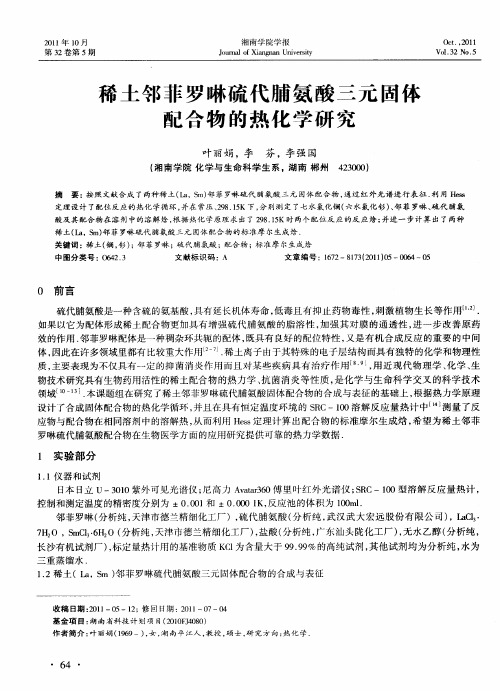
发 浓缩 至粘稠 状物 质 , 真空 干燥 , 固体 三元配 合 物 . 抽 得 红外 光谱 结果分 析 表 明 , 配合 物 的化学组 成 与文献 _ 相 符 为 [ E t h n c ] 3t0( E= L ,m) l R ( H)pe ・ k ・I c - R 2 aS .
长沙有机试剂厂)标定量热计用的基准物质 K 1 , C 为含量大于 9 . %的高纯试剂 , 99 9 其他试剂均为分析纯 , 水为
三重蒸馏水 .
12稀 土 (L , m ) 菲罗 啉硫代脯 氨酸三元 固体 配合物 的合成 与表征 . aS 邻
收稿 日期 : 1 —C —1 ; 回 日期 : 0 1 ( 一 4 0 2 l l 2 修 5 21 一 ) o 7
设计 了合成 固体配合 物的热 化学循 环 , 并且 在具有 恒定温 度环境 的 S C一10溶 解反 应 量热 计 中¨ R 0 测 量 了反
应物 与配合物 在相 同溶 剂 中的溶解 热 , 而利用 H s定 理计算 出配合 物 的标 准摩尔 生成 焓 , 望 为稀 土邻 菲 从 es 希
罗啉硫 代脯氨 酸配合 物在生 物医学 方面 的应用研究 提供可 靠 的热 力学数 据 .
基金 项 目 : 南省 科 技 计 划 项 目( 00 8 ) 湖 21F 0
作 者 简 介 : 丽娟 (9 9 , , 南 平 江人 , 授 , 士 , 究 方 向 : 化 学 叶 16 一) 女 湖 教 硕 研 热
・
6 ・ 4
叶丽娟 李 芬
李 强国: 稀土邻菲 罗啉硫代脯氨酸三元 固体配合物 的热化 学研 究
物技术 研究具 有生 物药用 活性 的稀 土配合 物 的热 力学 、 菌 消炎 等性 质 , 化学 与 生命 科学 交 叉 的科 学技 术 抗 是 领域 [ —3 . 课题 组在研究 了稀 土邻菲 罗啉硫代 脯氨 酸固体 配合物 的合成 与表征 的基础 上 , 据热力 学原 理 1 ]本 0 根
两个新颖的1,10-菲罗啉衍生物的合成及其金属配合物在水溶液中热力学稳定性的研究
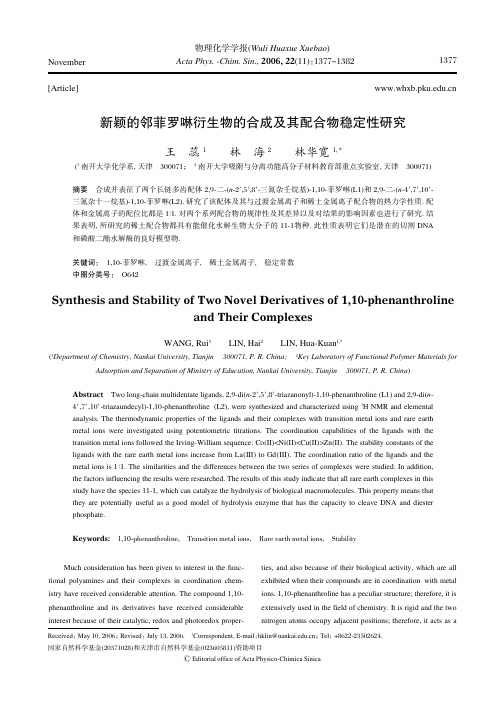
Much consideration has been given to interest in the func⁃tional polyamines and their complexes in coordination chem⁃istry have received considerable attention.The compound1,10⁃phenanthroline and its derivatives have received considerable interest because of their catalytic,redox and photoredox proper⁃ties,and also because of their biological activity,which are all exhibited when their compounds are in coordination with metal ions.1,10⁃phenanthroline has a peculiar structure;therefore,it is extensively used in the field of chemistry.It is rigid and the two nitrogen atoms occupy adjacent positions;therefore,it acts as a物理化学学报(Wuli Huaxue Xuebao)November Acta Phys.鄄Chim.Sin.,2006,22(11):1377~1382新颖的邻菲罗啉衍生物的合成及其配合物稳定性研究王蕊1林海2林华宽1,*(1南开大学化学系,天津300071;2南开大学吸附与分离功能高分子材料教育部重点实验室,天津300071)摘要合成并表征了两个长链多齿配体2,9⁃二⁃(n⁃2′,5′,8′⁃三氮杂壬烷基)⁃1,10⁃菲罗啉(L1)和2,9⁃二⁃(n⁃4′,7′,10′⁃三氮杂十一烷基)⁃1,10⁃菲罗啉(L2).研究了该配体及其与过渡金属离子和稀土金属离子配合物的热力学性质.配体和金属离子的配位比都是1∶1.对两个系列配合物的规律性及其差异以及对结果的影响因素也进行了研究.结果表明,所研究的稀土配合物都具有能催化水解生物大分子的11⁃1物种.此性质表明它们是潜在的切割DNA和磷酸二酯水解酶的良好模型物.关键词:1,10⁃菲罗啉,过渡金属离子,稀土金属离子,稳定常数中图分类号:O642Synthesis and Stability of Two Novel Derivatives of1,10鄄phenanthrolineand Their ComplexesWANG,Rui1LIN,Hai2LIN,Hua⁃Kuan1,*(1Department of Chemistry,Nankai University,Tianjin300071,P.R.China;2Key Laboratory of Functional Polymer Materials for Adsorption and Separation of Ministry of Education,Nankai University,Tianjin300071,P.R.China) Abstract Two long⁃chain multidentate ligands,2,9⁃di(n⁃2′,5′,8′⁃triazanonyl)⁃1,10⁃phenanthroline(L1)and2,9⁃di(n⁃4′,7′,10′⁃triazaundecyl)⁃1,10⁃phenanthroline(L2),were synthesized and characterized using1H NMR and elementalanalysis.The thermodynamic properties of the ligands and their complexes with transition metal ions and rare earthmetal ions were investigated using potentiometric titrations.The coordination capabilities of the ligands with thetransition metal ions followed the Irving⁃William sequence:Co(II)<Ni(II)<Cu(II)>Zn(II).The stability constants of theligands with the rare earth metal ions increase from La(III)to Gd(III).The coordination ratio of the ligands and themetal ions is1∶1.The similarities and the differences between the two series of complexes were studied.In addition,the factors influencing the results were researched.The results of this study indicate that all rare earth complexes in thisstudy have the species11⁃1,which can catalyze the hydrolysis of biological macromolecules.This property means thatthey are potentially useful as a good model of hydrolysis enzyme that has the capacity to cleave DNA and diesterphosphate.Keywords:1,10⁃phenanthroline,Transition metal ions,Rare earth metal ions,Stability[Article]Received:May10,2006;Revised:July13,2006.*Correspondent,E⁃mail:hklin@;Tel:+8622⁃23502624.国家自然科学基金(20371028)和天津市自然科学基金(023605811)资助项目ⒸEditorial office of Acta Physico⁃Chimica Sinica1377Acta Phys.鄄Chim.Sin.(Wuli Huaxue Xuebao),2006Vol.22goodπ⁃electron acceptor.Because of its peculiar structure,it can easily form feed backπ⁃bond,which has good coordination capacity with transition metal ions.Consequently,experiments with regard to the complexes of divalent transition metal ions (Co2+,Ni2+,Cu2+,Zn2+)and trivalent rare earth metal ions(La3+, Nd3+,Sm3+,Eu3+,Gd3+),which were used as the possible active species of mimic enzyme were carried out[1⁃3]because of their high number of coordination bonds and their high positive charge.As a further contribution in this area,two novel1,10⁃phenanthroline⁃bridged polyamine ligands(L1,L2)were devel⁃oped and synthesized.Besides the two nitrogen atoms of the aromatic ring,1,10⁃phenanthroline,there are additional six nitrogen atoms in the molecule;therefore,the coordination ca⁃pacity is considerably improved.Protonation constants of the two ligands and stability constants of their complexes with diva⁃lent transition metal ions(Cu2+,Zn2+,Co2+,Ni2+)and trivalent rare earth metal ions(La3+,Nd3+,Sm3+,Eu3+,Gd3+)were determined. 1Experimental1.1SynthesisAll the chemicals were of analytical reagent grade and pu⁃rified before use.2,9⁃dicarboxaldehyde⁃1,10⁃phenanthroline[4]and N⁃bromoethyl⁃ethylenediamine⁃hydrochloride[5⁃6]were synthesized according to the methods described in the literature.The1H NMR spectra were recorded using a Varian UNITY⁃plus400 MHz spectrometer.The elemental analyses were carried out on a Perkin⁃Elmer240C elemental analyzer.A mixture of N⁃bromoethyl⁃ethylenediamine⁃hydrochloride (15g)and25%methylamine solution(31mL)in water(20mL) was gently refluxed by stirring for15h.Following this,the mixture was filtered.Sodium hydroxide was then added to the residue in sufficient amounts such that it does not dissolve any⁃more.Due to the strong basicity,the solution separates into two layers.The upper layer and the ethereal extract of the lower layer were combined and then dried using anhydrous potassium carbonate for one day.The precipitate was filtered.Ether,water, and excessive methylamine were removed from the filtrate by normal distillation.By vacuum distillation,2.6g of product n⁃1,4,7⁃triazaoctane was obtained at72~75℃/1.1kPa[5].2,9⁃dicarboxaldehyde⁃1,10⁃phenanthroline(2.36g,10mmol) was dissolved in absolute ethanol(50mL),which were added in drops to a mixture of n⁃1,4,7⁃triazaoctane hydrochloride(4.98 g,22mmol),triethylamine(4.92mL,132mmol),and abso⁃lute ethanol(50mL).The mixture was then stirred for12h at room temperature under a nitrogen atmosphere.The mixture was then filtered,and solid NaBH4(1.5g,40mmol)was added in portions to the filtrate in an ice⁃cold water bath.After being heated and stirred for another6h at35~45℃,the solvent was removed under vacuum.The resultant white precipitate was dis⁃solved in water(10mL)containing NH4OAc(2g)and water phase was extracted with chloroform(4.80mL)and was com⁃bined with the organic phase,washed with water,and dried with MgSO4.The solvent was filtered and removed using a rotary evaporator to obtain light yellow oil that was further dissolved in a small amount of water.Following the addition of concentrated hydrochloric acid,the pH was adjusted suitably,the precipitate was filtered and recrystallized with methanol/ether.A total of2.4 g of light yellow powder2,9⁃di⁃(n⁃2′,5′,8′⁃triazanonyl)⁃1,10⁃phenanthroline(L1)was obtained.The synthesis of2,9⁃di⁃(n⁃4′, 7′,10′⁃triazaundecyl)⁃1,10⁃phenanthroline(L2)was similar to that of L1.Fig.1shows the processes involved in the preparation of ligands.L1:2,9⁃di⁃(n⁃2′,5′,8′⁃triazanonyl)⁃1,10⁃phenanthroline. Yield:35%.1H NMR(D2O,δ):δ7.79(d,2H,H3,8);δ8.06(s,2H, H5,6);δ8.58(s,2H,H4,7);δ4.80(s,4H,CH2);δ3.14(m,6H, CH3);δ3.54~3.66(m,16H,NHCH2).Elemental analysis:Calc. for C24H38N8·6HCl·3H2O,H:7.08%;C:40.52%;N:15.75%; Found,H:7.12%;C:40.39%;N:15.96%.L2:2,9⁃di⁃(n⁃4′,7′, 10′⁃triazaundecyl)⁃1,10⁃phenanthroline.Yield:33.2%.1H NMR (D2O,δ):δ7.92(d,2H,H3,8);δ8.06(s,2H,H5,6);δ8.61(s,2H, H4,7);δ4.84(s,4H,CH2);δ0.95(t,6H,CH2CH2CH3),δ1.67~1.73 (m,4H,CH2CH2CH3);δ3.07~3.11(m,4H,CH2CH2CH3),δ3.54~ 3.67(m,16H,NHCH2).Elemental analysis:Calc.for C28H46N8·6HCl·3H2O,H:7.62%;C:43.82%;N:14.60%.Found,H: 7.70%;C:43.77%;N:14.71%.1.2Potentiometric titrationsIn potentiometric experiments,all the aqueous solutions were prepared from redistilled water.The Cu(II),Zn(II),Co(II), Ni(II)nitrates were purchased from the Tianjin Third Chemistry Fig.1Processes involved in the preparation ofligands1378No.11LIN,Hua ⁃Kuan et al.:Synthesis and Stability of Two Novel Derivates of 1,10⁃phenanthroline and Their Complexes Reagent Factory,China.The La(III),Sm(III),Eu(III),Gd(III),Nd(III)perchlorates were prepared using the accurate weighing technique.All the metal ion solutions were standardized using ED TA.Titration was carried out with the help of a Beckman pH meter (model 椎71)equipped with a 39841⁃combination glass electrode.In potentiomatric titration experiments,the whole experi mental process was carried out at (25.0±0.1)℃using high ⁃purity N 2as an inert atmosphere.The concentrations of both ligands and metal ions in the experimental solutions were 0.5mmol ·L -1.The ionic strengths were maintained at I =0.1mol ·L -1by the addition of a known amount of 1mol ·L -1KNO 3.A small amount of dilute HNO 3was added to the solutes and then titrated with 0.1mol ·L -1KOH.For each system,at least three titrations were performed and at least 70experimental points were noted.The protonation constants and stability constants were calculated using the SCMAR program [7].2Results and discussion2.1Protonation constants of the ligandsIn the studied pH range (2.5~10.8),there were six stepwise protonation constants,results of which are shown in Table 1.Fig.2shows the species distribution curves.Six stepwise protonation constants can be obtained within the studied pH range.Each of the ligands contains eight nitrogen atoms.Two nitrogen atoms belong to o ⁃phenanthroline.The remaining six nitrogen atoms are located on the long ⁃chain mul ⁃tidentate side arm.Because the basicity of the nitrogen atom of o ⁃phenanthroline (p K a =4.75[8])is less than that of the secondary amine (p K a =9~10),all six protonations belong to the six nitrogen atoms on the side arm.Following the protonation of nitrogenatoms that are located on the long ⁃chain multidentate side arm,the electron cloud of the two nitrogen atoms of o ⁃phenanthroline is attracted by the positive charge of the six pro ⁃tons.The densi ⁃ties of the electron cloud of the two nitrogen atoms of phenan -throline are considerably reduced.The nitrogen atoms of o ⁃phenanthroline lose the ability to bind protons;there ⁃fore,the two nitrogen atoms of o ⁃phenanthroline cannot be protonated in the investigated pH range.From Table 1,the six stepwise protonation constants could be divided into three classes:9.95~9.39,8.65~7.12,and 5.02~3.63.The first class belongs to the two nitrogen atoms at the end of the long chain (N3).The second class forms the middle two (N2),and the third class forms the two (N1)that is bonded with the methylene linked with o ⁃phenanthroline.The electron ⁃with ⁃drawing effect of o ⁃phenanthroline reduces the basicity of N1.The positive charge of the protonated nitrogen atoms attracts the electron cloud of unprotonated nitrogen atoms;therefore,the protonation constants decrease step by step.Contrasting L1with L2,the end of the long chain of L1is methyl,whereas that of L2is propyl (the electron ⁃donating effect of propyl is stronger than that of methyl);however,the positions of other atoms are similar.So,the differences among the six stepwise protonation constants of the two ligands reduce sequen ⁃tially from N3to N1.From lg K 1to lg K 6,the differences betweenEquilibria L1L2[LH]/[L][H]9.60±0.049.95±0.04[LH 2]/[LH][H]9.39±0.039.70±0.03[LH 3]/[LH 2][H]8.51±0.038.65±0.04[LH 4]/[LH 3][H]7.12±0.047.25±0.03[LH 5]/[LH 4][H] 4.95±0.02 5.02±0.02[LH 6]/[LH 5][H]3.63±0.013.68±0.01Table 1Protonation constants of the ligands (lg K )pH=2.5~10.8,T=(25.0±0.1)℃,I =0.1mol ·L -1KNO 3,c L =0.5mmol ·L -1Fig.2Distribution curves of the protonation of the ligandsL1L21379Acta Phys.鄄Chim.Sin.(Wuli Huaxue Xuebao ),2006Vol.22L1and L2are 0.35,0.31,0.14,0.13,0.07,and 0.05,respectively.2.2Stability constants of ligands with Co(II),Ni(II),Cu(II),Zn(II)Table 2shows the stability constants of ligands L1and L2.Fig.3shows the species distribution curves (for example,Cu(II)).The stability constants were calculated using the three models,MLH 4,MLH 3,and MLH 2,within the investigated pH range (2.7~10.5),the three models were determined as 114,113,and 112,respectively.Their possible configurations are shown in Fig.4.From the distribution curves,it is obvious that when pH=3,the coordination does not occur,and so the ligands exist in the protonated form.With the increase in pH,the protons of the secondary amine N1dissociate.The divalent metal ion coordi ⁃nates with the nitrogen atoms of o ⁃phenanthroline and N1to form the model MLH 4.There are three five ⁃atom chelate rings in the complexes.With the further increase in pH,the two protons of N2dissociate sequentially and coordinate with the metal ion to form models MLH 3and MLH 2.The configuration is a regular octahedron.Among the six nitrogen atoms coordinated with the metal ion,the four nitrogen atoms of o ⁃phenanthroline and N1are on the plane position of the octahedron.N2is on the axial position.From the stability constants of L1and L2in Table 2,the coordination capabilities of ligands with the metal ions followed the Irving ⁃William sequence:Co(II)<Ni(II)<Cu(II)>Zn(II).As is well known,the stability constants of complexes par ⁃tially depend on the basicity of the secondary amine.As the electron ⁃donating effect of alkyl substituent increases,the basicity of the amino group is enhanced.Meanwhile,the steric hindrance weakens the coordination capability of the amino group.The two effects together determined the coordination capability.From Table 2,the six ⁃step stability constants of L1are larger than the corresponding step of L2.It shows that the effect of steric hindrance is stronger than the electron ⁃donating effect of the alkyl substituent in the coordination procedure.2.3Stability constants of ligands with La(III),Nd(III),Sm(III),Eu(III),Gd(III)The stability constants of the binary complexes of rare earth metal ions with ligands L1and L2are shown in Table 3.lg β114L1Cu(II)38.75±0.10Zn(II)38.14±0.09Co(II)37.36±0.08Ni(II)38.43±0.12L2Cu(II)37.96±0.09Zn(II)36.90±0.10lg β11333.45±0.1633.38±0.2132.27±0.1833.24±0.2332.85±0.1531.49±0.21lg β11226.27±0.2325.58±0.1824.90±0.2725.89±0.3325.89±0.1923.97±0.29Co(II)36.68±0.1231.52±0.2523.28±0.24Ni(II)37.76±0.0932.52±0.1925.31±0.21Table 2Stability constants of transition metal ions with the ligandspH=2.7~10.5,T =(25.0±0.1)℃,I =0.1mol ·L -1KNO 3,c L =0.5mmol ·L -1Fig.3Distribution curves of the Cu(II)complexes with the ligand L1at n (Cu(II))∶n (L1)=1∶1T=25.0℃,I =0.1mol ·L -1KNO 3,c L =0.5mmol ·L-1MLH 4MLH 3MLH 2Fig.4Possible configurations of binary complexes of L with Cu(II),Ni(II),Co(II),Zn(II)1380No.11LIN,Hua ⁃Kuan et al.:Synthesis and Stability of Two Novel Derivates of 1,10⁃phenanthroline and Their Complexes Fig.5shows the species distribution curves (for example,La(III)).Within the investigated pH range (2.7~10.5),by calculation of the five models,LnLH 2,LnLH,LnL,LnLH ⁃1,and LnLH ⁃2,are determined,which are represented by 112,111,110,11⁃1,and 11⁃2,respectively.Their possible configurations are shown in Fig.6.From the species distribution curves of La ⁃L1⁃H system,the ligands do not coordinate with rare earth metal ions at pH less than 6.H 6L 6+,H 5L 5+,H 4L 4+,and H 3L 3+exist in the solution.This is because that the rare earth metal ion is a hard acid;how ⁃ever,the nitrogen atom is the adjacent base.The coordination between the two is not easy.Even though the deprotonation of N1and N2occurs when pH=2~6,the binding force is so weakFig.5Distribution curves of the La(III)complexes of the ligand L1at n (La(III))∶n (L1)=1∶1T=25.0℃,I =0.1mol ·L -1KNO 3,c L =0.5mmol·L -1ConstantsLa(III)Nd(III)Sm(III)Eu(III)Gd(III)L1lg β11223.45±0.1023.50±0.1123.53±0.0923.71±0.1223.93±0.10lg β11115.35±0.1215.72±0.1516.19±0.2116.23±0.2616.39±0.24lg β110 6.84±0.157.70±0.188.19±0.208.33±0.278.35±0.19lg β11⁃1-2.33±0.20-1.60±0.21-1.23±0.25-0.48±0.16-0.55±0.20lg β11⁃2-12.23±0.28-11.16±0.24-11.02±0.27-10.08±0.19-10.16±0.25L2lg β11223.89±0.1123.97±0.1924.07±0.2324.22±0.1824.50±0.25lg β11115.86±0.2316.19±0.1616.53±0.2016.60±0.2716.78±0.31lg β1107.37±0.258.12±0.298.59±0.238.81±0.318.83±0.33lg β11⁃1-1.73±0.18-1.10±0.19-0.71±0.20-0.13±0.15-0.02±0.08lg β11⁃2-11.71±0.25-10.57±0.28-10.40±0.18-9.31±0.29-9.20±0.25Table 3Stability constants of rare metal ions with the ligandspH=2.7~10.5,T=(25.0±0.1)℃,I =0.1mol ·L -1KNO 3,c L =0.5mmol ·L-111⁃111⁃2Fig.6Possible configurations of binary complexes of L with Ln(III)1121111101381Acta Phys.鄄Chim.Sin.(Wuli Huaxue Xuebao),2006Vol.22 that the coordination is hard to form.When pH>6.0,the bind⁃ing force is so strong that the metal ions can coordinate withnitrogen atoms of o⁃phenanthroline and N1,N2,and the com⁃plex LnLH2is formed.With the increase in pH,the protons ofthe secondary amine N3dissociates,and LnLH,LnL are formedone after the other.Because of the chelating effect,the com⁃plexes are very stable.With the further increase in pH,andwhen pH>8.0,the coordinated water on central rare earth metalion begins to deprotonate,and LnLH⁃1and LnLH⁃2are formedsequentially.The maximum coordination number of central rareearth metal ion is10.From the stability constants of L1and L2in Table3,it can beseen that the stability constants increase from La(III)to Gd(III), that is to say,La(III)<Nd(III)<Sm(III)<Eu(III)<Gd(III). Although all the Ln(III)ions have the same charge,the ionic radii gradually decrease from La(III)to Gd(III):La(III)106pm; Nd(III)100pm;Sm(III)96pm;Eu(III)95pm;Gd(III)94pm[9]. The electron density of Ln(III)ions gradually increases,and thereby the coordination capability of Ln(III)with ligands grad⁃ually increases.Therefore,the stability constants increase gradu⁃ally from La(III)to Gd(III).The stability constants of rare earth metal complexes of L2are larger than those of the same metal complexes of L1.The reason is that the propyl of L2has a stronger electron⁃donating effect,which enhances the coordina⁃tion capability and the stability of complexes.However,accord⁃ing to the crystal⁃field theory,the rare earth metal ions usually have smaller coordination⁃field stabilization energy(ca4.18kJ·mol-1)than the transition metal ions(逸418kJ·mol-1)[10].So, when the rare earth metal ions are coordinated with the ligand, they mainly form the electrovalent bond that has a weaker ori⁃entation effect.The ligand has accordingly a greater steric choice for coordination,which alleviates the tension that is observed during the formation of the five⁃member chelate ring. In addition,the rare earth metal ions have larger radii,as a result of which the adverse steric effect is reduced.In addition,from the graph of lg茁vs angular momentum of metal ions(Fig.7,consider the model species111,110,11⁃1for example),it is obvious that they have a good linear relation. This is in agreement with the“inclined W”regulation,which is generalized by Sinha[11].When compared with transition metals,the rare earth metal ions have larger ionic radius that reduces the steric hindrance effect of the substituent.So,the stability of the complexes of L2 is higher than that of L1,which is contrary to that of the transi⁃tion metal ions.This result indicates that the electron⁃donating effect of alkyl substituent is stronger than the effect of steric hin⁃drance in the rare earth metal ions coordination procedure.It is important to note that rare earth complexes contain the species 11⁃1that can catalyze the hydrolysis of biological macro⁃molecules,and the p K a is at about8~9,which is close to the p K a of human body.This property means that they are potentially useful as a good model of hydrolysis enzyme that has the capacity to cleave DNA and diester phosphate.References1Luo,Y.H.;Lin,H.K.;Lin,H.Transitonn Metal Chemistry,2006, 31:1032Liu,Q.;Lin,H.K.;Lin,H.Transition Metal Chemistry,2006,31: 3253Lin,H.K.;Luo,Y.H.;Lin,H.Transition Metal Chemistry,2006, 31:6904Madeja,K.J.Parkt.Chem.,1962,17:975O′Gee,R.C.;Woodburn,H.W.J.Am.Chem.Soc.,1951,23:1370 6Guo,Y.H.Ph.D.Dissertation.Tianjin:Nankai University,2002 [郭延河.博士学位论文.天津:南开大学,2002]7Sun,H.W.Ph.D.Dissertation.Tianjin:Nankai University,1998 [孙宏伟.博士学位论文.天津:南开大学,1998]8Xia,H.T.;Lin,H.K.;Chen,R.T.Chinese Journal of Inorganic Chemistry,1994,10:363[夏海涛,林华宽,陈荣悌.无机化学学报(Wuji Huaxue Xuebao),1994,10:363]9Yao,Y.B.;Xie,T.;Gao,Y.M.Handbook of physical chemistry.Shanghai:Shanghai Science and Technology Publishing Company, 1985:99⁃104[姚允斌,解涛,高英敏.物理化学手册.上海:上海科学技术出版社,1985:99⁃104]10Peppard,D.F.;Bloomquist,C.A.A.;Horwitz,E.P.;lewey,S.;Mason,G.W.J.Inorg.Nucl.Chem.,1970,32:33911Sinha,S.P.Helv.Chim.Acta,1975,58:1978Fig.7Relation of lg茁and angular momentum of metal ion1382。
5-硝基-1,10-邻菲罗啉的合成及性质研究
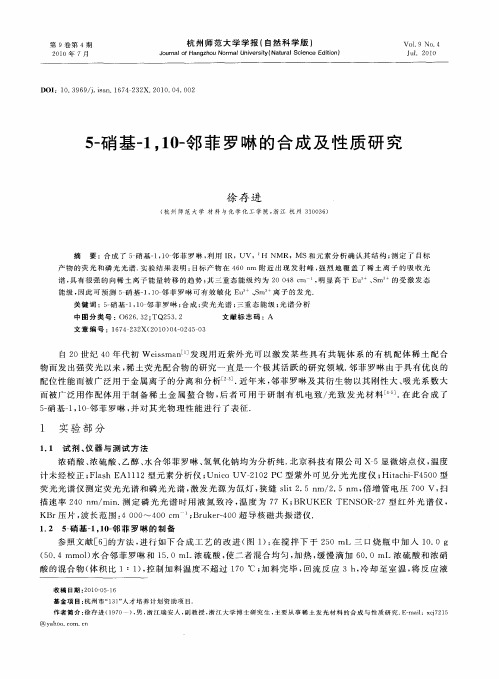
基 金 项 目 : 州 市 “ 1 人 才 培 养 计 划 资助 项 目. 杭 1 ” 3 作 者 简 介 : 存 进 ( 9 0 ) 男 , 江瑞 安 人 , 教 授 , 江 大 学 博 士 研 究 生 , 要 从 事 稀 土 发 光 材 料 的合 成 与 性 质 研 究 . — i c 2 5 徐 17 , 浙 副 浙 主 E mal j 1 :x 7
Vo19 NO. . 4
J1 0 O u .2 l
DOI 0 3 6 /.sn 1 7 3 X. 0 0 0 . 0 :l . 9 9 jis . 6 42 2 2 1 . 4 0 2
5 硝 基 一 , 邻 菲 罗 啉 的 合 成 及 性 质 研 究 一 1 1一 0
徐 存 进
( 杭州 师 范 大 学 材 料 与化 学 化3 学 院 , 江 杭 州 3 0 3 ) _ - 浙 】 0 6
中 图 分 类 号 :0 2 . 2 T 5 . 6 6 3 ; Q2 3 2
文 章 编 号 :1 7 3 X( 0 0 0 — 2 5 0 6 4 2 2 2 1 ) 4 0 4 3
文 献 标 志码 : A
自2 0世 纪 4 0年 代 初 W esma 口 发 现 用 近 紫 外 光 可 以 激 发 某 些 具 有 共 轭 体 系 的 有 机 配 体 稀 土 配 合 is n
计 未经 校 正 ; ls A1 1 F ah E 1 2型元 素分 析仪 ; iouV一1 2P Unc 2 0 C型 紫外 可 见分 光光 度 仪 ; tc i 4 0 Hi h— 5 0型 a F 荧光 光谱 仪测 定荧 光 光谱 和磷 光 光谱 , 发 光源 为 氙灯 , 缝 si 2 5n 2 5n 倍增 管 电压 7 0 V, 激 狭 l . m/ . m, t 0 扫 描速率 2 0 n mi. 定 磷 光 光 谱 时用 液 氮 致 冷 , 度 为 7 B 4 m/ n 测 温 7K; RUKE NS 一7型红 外 光 谱 仪 , R TE OR 2
镝芳香族羧酸与邻菲罗啉配合物的合成、结构、热分解机理及动力学的研究
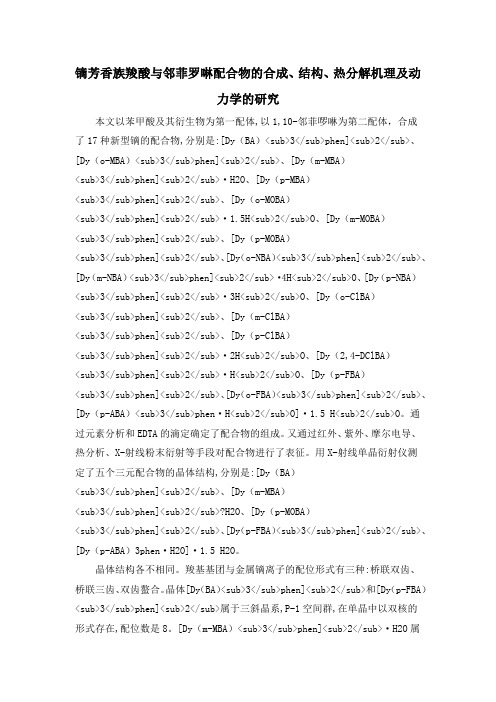
镝芳香族羧酸与邻菲罗啉配合物的合成、结构、热分解机理及动力学的研究本文以苯甲酸及其衍生物为第一配体,以1,10-邻菲啰啉为第二配体,合成了17种新型镝的配合物,分别是:[Dy(BA)<sub>3</sub>phen]<sub>2</sub>、[Dy(o-MBA)<sub>3</sub>phen]<sub>2</sub>、[Dy(m-MBA)<sub>3</sub>phen]<sub>2</sub>·H2O、[Dy(p-MBA)<sub>3</sub>phen]<sub>2</sub>、[Dy(o-MOBA)<sub>3</sub>phen]<sub>2</sub>·1.5H<sub>2</sub>O、[Dy(m-MOBA)<sub>3</sub>phen]<sub>2</sub>、[Dy(p-MOBA)<sub>3</sub>phen]<sub>2</sub>、[Dy(o-NBA)<sub>3</sub>phen]<sub>2</sub>、[Dy(m-NBA)<sub>3</sub>phen]<sub>2</sub>·4H<sub>2</sub>O、[Dy(p-NBA)<sub>3</sub>phen]<sub>2</sub>·3H<sub>2</sub>O、[Dy(o-ClBA)<sub>3</sub>phen]<sub>2</sub>、[Dy(m-ClBA)<sub>3</sub>phen]<sub>2</sub>、[Dy(p-ClBA)<sub>3</sub>phen]<sub>2</sub>·2H<sub>2</sub>O、[Dy(2,4-DClBA)<sub>3</sub>phen]<sub>2</sub>·H<sub>2</sub>O、[Dy(p-FBA)<sub>3</sub>phen]<sub>2</sub>、[Dy(o-FBA)<sub>3</sub>phen]<sub>2</sub>、[Dy(p-ABA)<sub>3</sub>phen·H<sub>2</sub>O]·1.5 H<sub>2</sub>O。
稀土席夫碱邻菲罗啉三元配合物的合成及活性研究

Pr 。 ,Nd 。 。 _ ,S m。 。 _ ) wa s s y n t h e s i z e d wi t h c o o r d i n a t e r e a c t i o n c o n t a i n i n g S c h i f f b a s e ,p h e n a n t h r o I i n e a n d r a r e e a r t h
( C o l l e g e o f Li f e S c i e n c e a n d Ch e mi s t r y,Ti a n s h u i No r ma l Un i v e r s i t y ,Ti a n s h u i 7 4 1 0 0 1 ) Ab s t r a c t Ra r e e a r t h S c h i f f b a s e a n d p h e n a n t h r o l i n e t e r n a r y c o mp l e x e s REM ( o — p h e n ) 2 C1 ・2 H2 O( M — La ” ,
2 H2 O 的抑 菌 活性 最好 。
关 键 词 稀土 邻菲罗啉 三元配合物 结构表征 抑菌活性
中图分类号 : 06 2 2 . 6
文献标识码 : A
S y n t h e s i s a nd Bi o l o g i c a l Ac t i v i Co m pl e x e s wi t h
摘要
以席 夫碱I N, N , 双( 2 , 4 一 二羟基 苯甲醛) 缩邻苯二 胺] ( I ) 和邻 菲罗啉 为配体 , 与稀 土金 属 离子配位 合
成 了稀 土 席 夫 碱 邻 菲 罗啉 三 元 配 合 物 R E M( o — p h e n ) 2 C 1 ・2 H2 O( M- 二L a 、P r 、 Nd ”、 S ma 。 。 ) , 并利 用红外光谱 、 紫 外 可见光谱 、 元 素 分析 和摩 尔 电导 率 仪 对 其 结 构 进 行 了分 析 表 征 , 同 时将 该 类 配 合 物 应 用 于 生 物 活性 抑 菌试 验 。 结 果表 明 , 所 有 配合 物 对 大肠 杆 菌 、 金 黄 色 葡 萄球 菌和 白 色 念珠 菌都 有 较 好 的 抑 菌作 用 , 且 配 合 物 RE S m( o — p h e n ) 2 C 1 ・
稀土配合物Tb_p_MBA_3phen的有机电致发光(精)
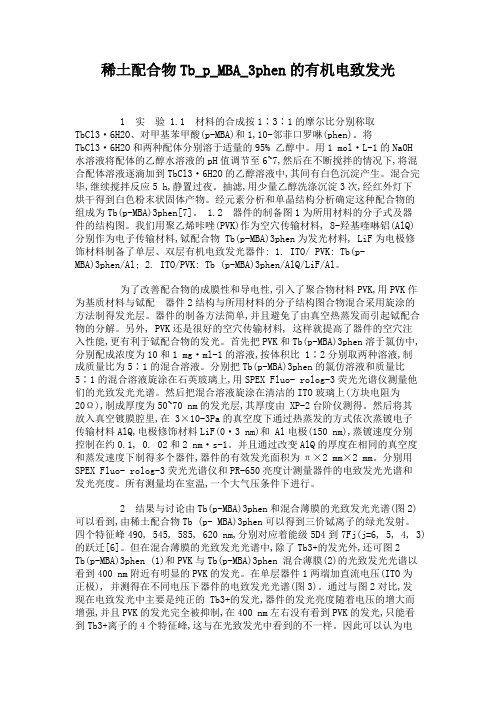
稀土配合物Tb_p_MBA_3phen的有机电致发光1 实验 1.1 材料的合成按1∶3∶1的摩尔比分别称取TbCl3·6H2O、对甲基苯甲酸(p-MBA)和1,10-邻菲口罗啉(phen)。
将TbCl3·6H2O和两种配体分别溶于适量的95% 乙醇中。
用1 mol·L-1的NaOH水溶液将配体的乙醇水溶液的pH值调节至6~7,然后在不断搅拌的情况下,将混合配体溶液逐滴加到TbCl3·6H2O的乙醇溶液中,其间有白色沉淀产生。
混合完毕,继续搅拌反应5 h,静置过夜。
抽滤,用少量乙醇洗涤沉淀3次,经红外灯下烘干得到白色粉末状固体产物。
经元素分析和单晶结构分析确定这种配合物的组成为Tb(p-MBA)3phen[7]。
1.2 器件的制备图1为所用材料的分子式及器件的结构图。
我们用聚乙烯咔唑(PVK)作为空穴传输材料, 8-羟基喹啉铝(AlQ)分别作为电子传输材料,铽配合物 Tb(p-MBA)3phen为发光材料, LiF为电极修饰材料制备了单层、双层有机电致发光器件: 1. ITO/ PVK: Tb(p-MBA)3phen/Al; 2. ITO/PVK: Tb (p-MBA)3phen/AlQ/LiF/Al。
为了改善配合物的成膜性和导电性,引入了聚合物材料PVK,用PVK作为基质材料与铽配器件2结构与所用材料的分子结构图合物混合采用旋涂的方法制得发光层。
器件的制备方法简单,并且避免了由真空热蒸发而引起铽配合物的分解。
另外, PVK还是很好的空穴传输材料, 这样就提高了器件的空穴注入性能,更有利于铽配合物的发光。
首先把PVK和Tb(p-MBA)3phen溶于氯仿中, 分别配成浓度为10和1 mg·ml-1的溶液,按体积比1∶2分别取两种溶液,制成质量比为5∶1的混合溶液。
分别把Tb(p-MBA)3phen的氯仿溶液和质量比5∶1的混合溶液旋涂在石英玻璃上,用SPEX Fluo- rolog-3荧光光谱仪测量他们的光致发光光谱。
5-氯-2-甲氧基苯甲酸与1,10-邻菲哕啉稀土配合物的合成、表征及热分解机理
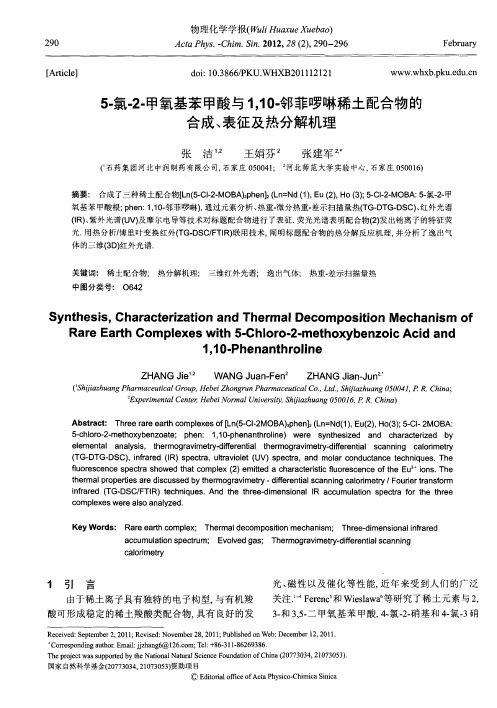
ee n a a ay i. t e mo r vm er die e t l t e mo rvm er. f r n i s a nn c o i t lme t I n lss h r ga i t y— f r n i h r g a i tydie e t a al c n ig alrmer y
ter I r p risa e ds u s d b e mo a i t h ma o e t r ic s e yt r grvme r p e h y—df eniI c n ig c lr t ier t a nn ao i r as me y,F u ir rn fI o r a scr e t m
F b ur e ra y
、w、. x .k .d .I ^ ) r l , bp u e uCI wh
பைடு நூலகம்
[ t l] Ari e c
5氯.- 基苯 甲酸 与 11 - 一 2 甲氧 ,0邻菲哕啉稀 土配合物 的 合成 、 表征及热分解机理
张 洁 王娟芬 张建军 ・
( 石药集 团河北 中润制药有 限公 司, 石家庄 004; 河北 师范大学实验 中心, 501 石家庄 001) 506
(G— T D C) if rd( )s e t , la il U s e t , n lrc n u tn etc n u s T e T D G- S ,nr e I p cr ut voe V) p cr a d moa o d ca c e h i e . h a R a r t( a q
丁二酸、1,10-菲啰啉构筑稀土配合物的合成、表征及与DNA作用的光谱学研究
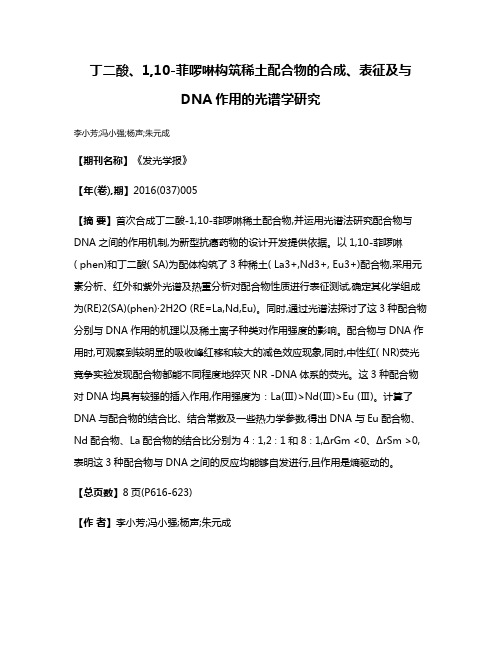
丁二酸、1,10-菲啰啉构筑稀土配合物的合成、表征及与DNA作用的光谱学研究李小芳;冯小强;杨声;朱元成【期刊名称】《发光学报》【年(卷),期】2016(037)005【摘要】首次合成丁二酸-1,10-菲啰啉稀土配合物,并运用光谱法研究配合物与DNA之间的作用机制,为新型抗癌药物的设计开发提供依据。
以1,10-菲啰啉( phen)和丁二酸( SA)为配体构筑了3种稀土( La3+,Nd3+, Eu3+)配合物,采用元素分析、红外和紫外光谱及热重分析对配合物性质进行表征测试,确定其化学组成为(RE)2(SA)(phen)·2H2O (RE=La,Nd,Eu)。
同时,通过光谱法探讨了这3种配合物分别与DNA作用的机理以及稀土离子种类对作用强度的影响。
配合物与DNA作用时,可观察到较明显的吸收峰红移和较大的减色效应现象,同时,中性红( NR)荧光竞争实验发现配合物都能不同程度地猝灭NR -DNA体系的荧光。
这3种配合物对DNA均具有较强的插入作用,作用强度为:La(Ⅲ)>Nd(Ⅲ)>Eu (Ⅲ)。
计算了DNA与配合物的结合比、结合常数及一些热力学参数,得出DNA 与Eu配合物、Nd配合物、La配合物的结合比分别为4∶1,2∶1和8∶1,ΔrGm <0、ΔrSm >0,表明这3种配合物与DNA之间的反应均能够自发进行,且作用是熵驱动的。
【总页数】8页(P616-623)【作者】李小芳;冯小强;杨声;朱元成【作者单位】天水师范学院化工学院,甘肃天水 741001;天水师范学院化工学院,甘肃天水 741001;定西师专化学系,甘肃定西743000;天水师范学院化工学院,甘肃天水 741001【正文语种】中文【中图分类】O629.74【相关文献】1.2-(4-羟基苯基)咪唑并[4,5-f][1,10]菲啰啉的合成、表征及抑菌活性研究 [J], 曹虹;董风英;王艳丽;李宁;赵鑫;孙晓风;孙云明2.芳香胺氮氧化物合贵金属配合物研究Ⅱ、1,10-菲啰啉-N-氧化物与金(Ⅲ)、铂(Ⅳ)和钯(Ⅱ)的配合物的合成与表征 [J], 龚钰秋;姜美春;孙鑫泉3.甲酰基甲酸缩氨基硫脲和1,10-菲啰啉的过渡金属配合物的合成、表征及杀菌活性 [J], 刘树祥;高恩庆;田君濂;毕思玮;张建民;李桂芝4.1,10-菲啰啉-1-氧化物与重稀土丙烯酸盐配合物的合成及表征 [J], 李长正;闫福林;李红星;孙建辉;祝振富5.协萃络合物结构的研究——二(1-苯基-3-甲基-4-三氟乙酰基吡唑啉酮-5)-(1,10菲啰啉)合钴(Ⅱ)的合成、表征与晶体结构的测定 [J], 王科志;黄春辉;翁诗甫;徐光宪;韩玉真;贺存恒;郑启泰因版权原因,仅展示原文概要,查看原文内容请购买。
稀土-姜黄素-菲啰啉配合物荧光和抑菌活性研究
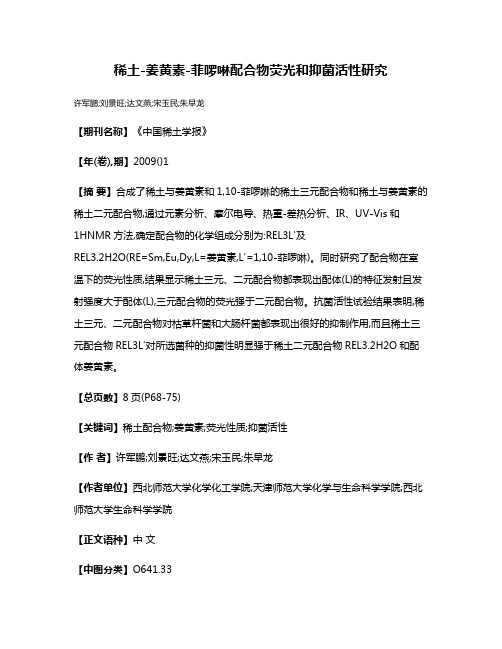
稀土-姜黄素-菲啰啉配合物荧光和抑菌活性研究许军鹏;刘景旺;达文燕;宋玉民;朱早龙【期刊名称】《中国稀土学报》【年(卷),期】2009()1【摘要】合成了稀土与姜黄素和1,10-菲啰啉的稀土三元配合物和稀土与姜黄素的稀土二元配合物,通过元素分析、摩尔电导、热重-差热分析、IR、UV-Vis和1HNMR方法,确定配合物的化学组成分别为:REL3L′及REL3.2H2O(RE=Sm,Eu,Dy,L=姜黄素,L′=1,10-菲啰啉)。
同时研究了配合物在室温下的荧光性质,结果显示稀土三元、二元配合物都表现出配体(L)的特征发射且发射强度大于配体(L),三元配合物的荧光强于二元配合物。
抗菌活性试验结果表明,稀土三元、二元配合物对枯草杆菌和大肠杆菌都表现出很好的抑制作用,而且稀土三元配合物REL3L′对所选菌种的抑菌性明显强于稀土二元配合物REL3.2H2O和配体姜黄素。
【总页数】8页(P68-75)【关键词】稀土配合物;姜黄素;荧光性质;抑菌活性【作者】许军鹏;刘景旺;达文燕;宋玉民;朱早龙【作者单位】西北师范大学化学化工学院;天津师范大学化学与生命科学学院;西北师范大学生命科学学院【正文语种】中文【中图分类】O641.33【相关文献】1.邻菲啰啉及其配合物对人参锈腐病菌的抑菌活性 [J], 申凤善;李熙英;张莲姬2.聚(苯乙烯-丙烯酸)载体铁邻菲啰啉(5-硝基邻菲啰啉)配合物的合成及其对丁二烯聚合的催化活性 [J], 曲雅焕;于广谦;李玉良;尹作瑞3.苯甲酸系列邻菲啰啉硝酸根稀土四元混配配合物的合成、表征和抗菌活性研究[J], 赵曙辉;咸春颖;李文刚;黄象安4.钇、镱氯代苯甲酸与1,10-邻菲啰啉三元配合物的合成及抑菌活性 [J], 韩华;刘媛媛;陈志民;王淑萍;王瑞芬;赵宝华5.铒-对甲苯磺酰组氨酸-邻菲啰啉三元配合物的合成及其抑菌活性 [J], 李晓慧;王卫东;李煜林;陆江林因版权原因,仅展示原文概要,查看原文内容请购买。
稀土离子-1,10-菲罗啉桥联多胺二元配合物的稳定性研究
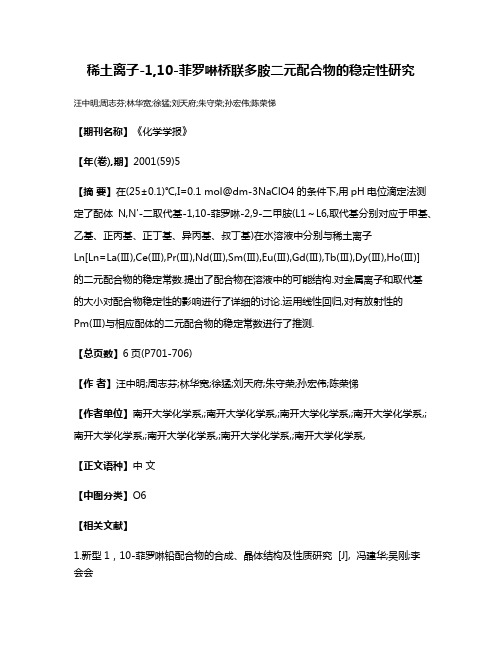
稀土离子-1,10-菲罗啉桥联多胺二元配合物的稳定性研究汪中明;周志芬;林华宽;徐猛;刘天府;朱守荣;孙宏伟;陈荣悌【期刊名称】《化学学报》【年(卷),期】2001(59)5【摘要】在(25±0.1)℃,I=0.1 mol@dm-3NaClO4的条件下,用pH电位滴定法测定了配体N,N'-二取代基-1,10-菲罗啉-2,9-二甲胺(L1~L6,取代基分别对应于甲基、乙基、正丙基、正丁基、异丙基、叔丁基)在水溶液中分别与稀土离子Ln[Ln=La(Ⅲ),Ce(Ⅲ),Pr(Ⅲ),Nd(Ⅲ),Sm(Ⅲ),Eu(Ⅲ),Gd(Ⅲ),Tb(Ⅲ),Dy(Ⅲ),Ho(Ⅲ)]的二元配合物的稳定常数.提出了配合物在溶液中的可能结构.对金属离子和取代基的大小对配合物稳定性的影响进行了详细的讨论.运用线性回归,对有放射性的Pm(Ⅲ)与相应配体的二元配合物的稳定常数进行了推测.【总页数】6页(P701-706)【作者】汪中明;周志芬;林华宽;徐猛;刘天府;朱守荣;孙宏伟;陈荣悌【作者单位】南开大学化学系,;南开大学化学系,;南开大学化学系,;南开大学化学系,;南开大学化学系,;南开大学化学系,;南开大学化学系,;南开大学化学系,【正文语种】中文【中图分类】O6【相关文献】1.新型1,10-菲罗啉铅配合物的合成、晶体结构及性质研究 [J], 冯建华;吴刚;李会会2.2,9-二(n-2′,5′-二氮杂庚基)-1,10-菲罗啉镍(Ⅱ)配合物的合成、晶体结构及生物活性研究 [J], 李风华;刘天府;吴红星;林华宽;江冬青;朱守荣3.两个新型的1,10-菲罗啉桥联多胺配体及其配合物的合成与热力学性质 [J], 李玉玲;林海;林华宽4.铽与苯乙酮酸、2,2′-联吡啶、1,10-菲口罗啉、三苯基氧膦铽三元配合物的合成、结构表征及荧光性能的研究 [J], 张彦辉;孙波;裴娟;耿啸天;王云友;颜剑波5.稀土离子与2,9-二甲基-1,10-菲罗啉的α-氨甲基吡啶衍生物的二元配合物的稳定性研究 [J], 刘天府;汪中明;周志芬;林华宽;朱守荣;徐猛;陈荣悌因版权原因,仅展示原文概要,查看原文内容请购买。
- 1、下载文档前请自行甄别文档内容的完整性,平台不提供额外的编辑、内容补充、找答案等附加服务。
- 2、"仅部分预览"的文档,不可在线预览部分如存在完整性等问题,可反馈申请退款(可完整预览的文档不适用该条件!)。
- 3、如文档侵犯您的权益,请联系客服反馈,我们会尽快为您处理(人工客服工作时间:9:00-18:30)。
21 0 0年 6月
北华大学学报 ( 自然科学 版)
J U N LO EH A U IE ST N trl cec ) O R A FB I U NV R IY( aua S i e n
V0.1 . J l No 3
J n2 1 u .0 0
i te a i ei aa o e c mp e e e e a ay e y u ig t e Ac a n o t— e ee n meh d , e h s h r lk n t d t f h o l x sw r n lz d b s h ra d C as R d f r to s t n t e o m c t n h h
Abta t T rel ta i o l e d p e )( H C 0) ( O ) 1 , u( hn 2 N 3 3 2) n o s c : he nhnd cmpe sN ( hn C 3 O 2 N 3 ( ) E p e ) ( O ) ( a d H r a e x ( hn 2 N 3 3 3 w r snh s e i ,0p e o n ( hn a gn h yt f tH / 2 . h p e ) ( O ) ( ) ee y tei d wt 1 1 一h nl e p e ) sl ad i tess m o O H 0 T e z h i i n e E
摘要 : 乙醇一 在 水混合体系 中合成 了 1 1 一 ,0菲哕啉 ( hn 的三 种稀土 配合物 N ( hn ( H C 0) ( O ) 1 , pe) d p e ) C O : N ( )
E ( hn ( O ) ( ) H ( hn N , 3 3 . u p e ) N , 2 , o p e )( O ) ( )采用 T — T G D G和 D A技术研究 了配合物在静态 氮气 中的热分解 T 过程 , 用 A hr 并 c a 法和 C a .efr ot R de s n法对各配合物的非等温热 力学数据进 行 了分析 , 推断 出各反应 的热分解反 应机理及热分解反应动力学方程式 , 计算 出了其表观活化能( ) E 和指前 因子 的对数值 (n ) 1A . 关键词 : 稀土配合物 ; ,0菲哕啉 ; 11 一 热分解动力 学 中图分类号 :6 3 0 4 文献标志码 : A
W AN Ja -h n , G in z o g YUA u q n, HA i a XI N Ho — u Z O Ha— n, NG n —e g y Yo gh n
( ol eo hmir n hmi l n i e n ,ioigN r a n e i D l n16 2 ,hn ) C lg C e syad C e c gn r g L nn om l i m@, ai 1 09 C i e f t aE ei a Uv a a
po sb e r a t n me h n s f te t e a e o o iin n i e i q ai n we e s g e t d, n a u s o s il e ci c a ims o h h r l d c mp st s a d k n t e u to r u g se a d v le f o m o c
t e ma e o o i o so h o lx swe e su id i ttc n to e y TG— h r ld c mp st n ft e c mp e e r t d e n sai ir g n b i DTG n a d DTA t o s Th o — me h d . e n n
文章 编 号 :0 94 2 ( 0 0 0 -2 80 10 -82 2 1 ) 30 1 - 4
稀 土 一 ,O 菲 哕啉 配合 物 的热 分解 动力 学研 究 11 一
王建忠 , 袁厚群 , 赵海燕 , 永恒 邢
( 辽宁师 范大学 化学化工学院 , 辽宁 大连 162 ) 10 9
稀 土元素 因其特 殊 的电子构 型而表现 出其他 元素 所不 具备 的光 、 磁 等特性 , 电、 在工 业 、 化学 、 化及 生 医学上有着广泛的应用¨ , 其与芳香族羧酸 、 氮杂芳环配体形成的配合物可用于发光及功能材料等方面 ,
引起了人们广泛的关注. 近年来, 人们对以 pe 作为第一配体 , hn 以苯 甲酸 、 J水杨酸 、 ]吡啶羧酸类H 别等 其他芳香羧酸类作为第二配体的稀土三元配合物的研究报道较多. 但大多数报道仅 限于对配合物结构的 研 究和对 所合成 配合物 热分解 过程 的简单描 述 , 而对该 类 配合 物热 分解 动 力学 方 面 的研究 报 道很 少 ] .
S u i s o he Th r a c m p sto n t s o n ha i e t d e n t e m lDe o o ii n Ki e i f La t n d c Co p e e t 1 - h n l e a g n m lx s wih 1, 0 p e o i s Li a d n
at ai n ri ( a dpeep nni c r(n w r i nrset ey 1A) eeg e ep c vl. i o s x af o v i
Ke r :ln h nd o lx; 1 p e oi e;h r a e o o iin y wo ds a t a ie c mp e 1, 0一 h n ln t e l d c mp sto m
